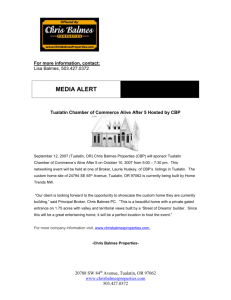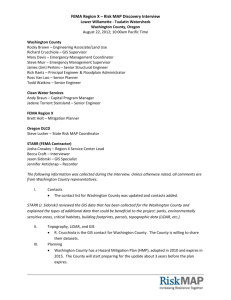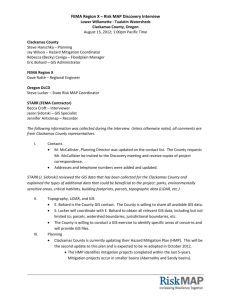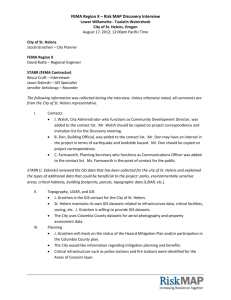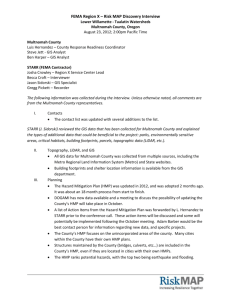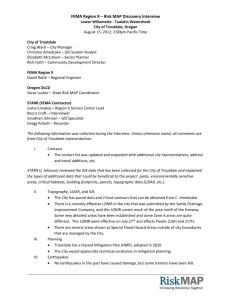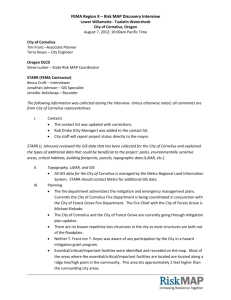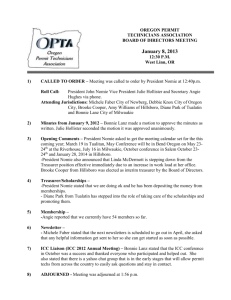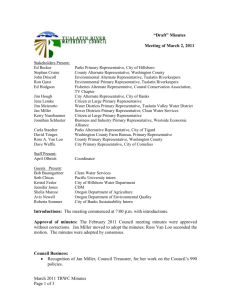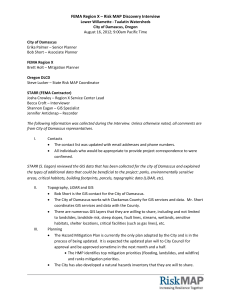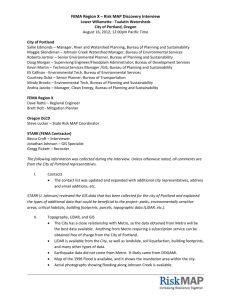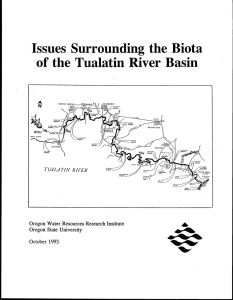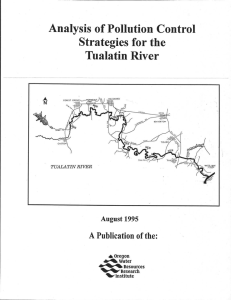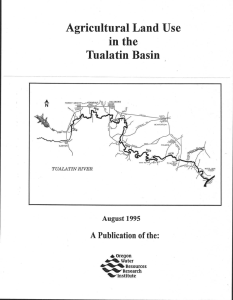FOR FEMA AND STATE REVIEW-MeetingMinutes
advertisement
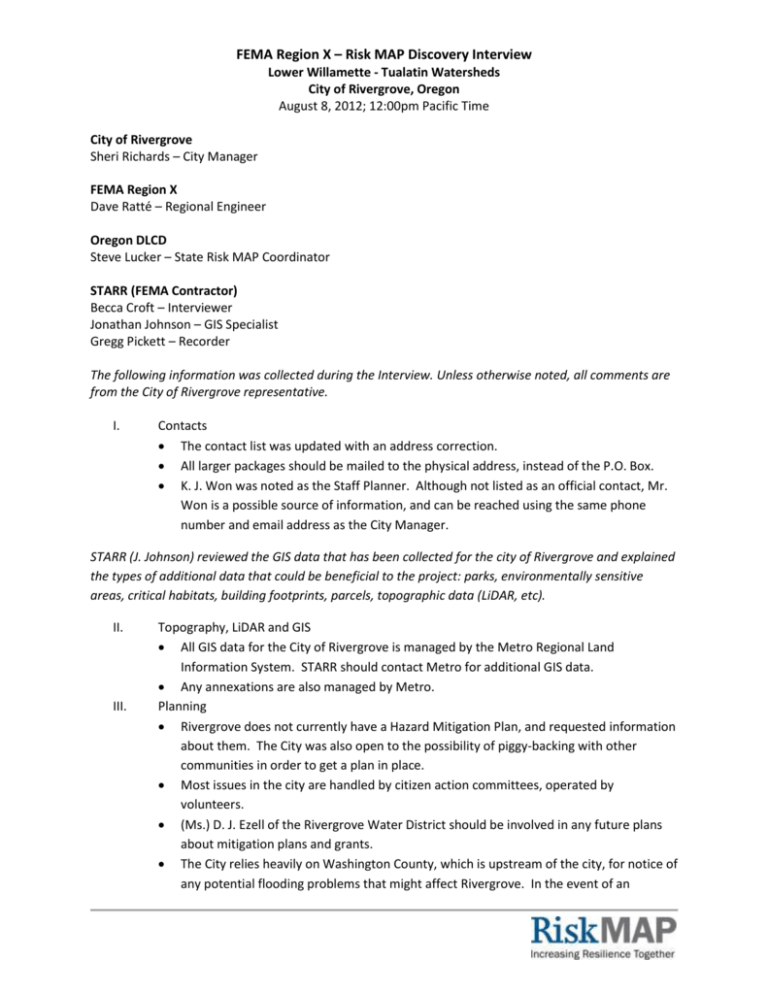
FEMA Region X – Risk MAP Discovery Interview Lower Willamette - Tualatin Watersheds City of Rivergrove, Oregon August 8, 2012; 12:00pm Pacific Time City of Rivergrove Sheri Richards – City Manager FEMA Region X Dave Ratté – Regional Engineer Oregon DLCD Steve Lucker – State Risk MAP Coordinator STARR (FEMA Contractor) Becca Croft – Interviewer Jonathan Johnson – GIS Specialist Gregg Pickett – Recorder The following information was collected during the Interview. Unless otherwise noted, all comments are from the City of Rivergrove representative. I. Contacts The contact list was updated with an address correction. All larger packages should be mailed to the physical address, instead of the P.O. Box. K. J. Won was noted as the Staff Planner. Although not listed as an official contact, Mr. Won is a possible source of information, and can be reached using the same phone number and email address as the City Manager. STARR (J. Johnson) reviewed the GIS data that has been collected for the city of Rivergrove and explained the types of additional data that could be beneficial to the project: parks, environmentally sensitive areas, critical habitats, building footprints, parcels, topographic data (LiDAR, etc). II. III. Topography, LiDAR and GIS All GIS data for the City of Rivergrove is managed by the Metro Regional Land Information System. STARR should contact Metro for additional GIS data. Any annexations are also managed by Metro. Planning Rivergrove does not currently have a Hazard Mitigation Plan, and requested information about them. The City was also open to the possibility of piggy-backing with other communities in order to get a plan in place. Most issues in the city are handled by citizen action committees, operated by volunteers. (Ms.) D. J. Ezell of the Rivergrove Water District should be involved in any future plans about mitigation plans and grants. The City relies heavily on Washington County, which is upstream of the city, for notice of any potential flooding problems that might affect Rivergrove. In the event of an Risk MAP Discovery Interview – Lower Willamette - Tualatin Watersheds City of Rivergrove – August 8, 2012 IV. V. VI. VII. VIII. Page 2 of 3 impending flooding event, the City Manager would receive word from Washington County, and then the City Manager would begin alerting the citizens through email and the community phone tree. No essential/critical/important facilities were identified and recorded on the map. The city is entirely residential and there are no city-owned buildings or other critical facilities. Tualatin Valley Fire and Rescue are the nearest emergency responders, and manage any emergency response plans. Depending on proximity, availability, and other factors (such as which cell phone tower the emergency call comes from), other emergency responders from Washington County and/or the City of Lake Oswego may respond to emergencies within the city. There is no Reverse 911 system in place for Rivergrove. 6 acres of land in 2 parks, including 4 acres of completely undeveloped land in the floodplain close to the Tualatin River, are owned by the City. Earthquakes S. Richards was unaware of any earthquakes in the city, but had seen a map that showed an earthquake fault going directly through the city, but could not recall where she had seen the map. Wildfires The wildfire threat is minimal. The city has some wooded areas in and adjacent to the city, but has no history of any wildfires. Landslides There are no known historic landslides in the city. Severe Storms High winds are the most likely cause of storm damage in the city, although the city has no history of severe damage or long-term power outages. Scott Porter of Tualatin Valley Fire and Rescue was noted as an excellent source of any information regarding high winds and any type of severe weather information. Douglas fir trees reach up to 150 feet tall in the city, but other smaller species of trees are actually more likely to fall and cause damage to power lines and property. The City has a development review process that includes the potential of tree damage. The primary source for residents to obtain information in a storm event is by email and by phone tree. The City Manager has the email addresses of approximately 55%-60% of the residents as well as an extensive phone tree to be used in the event of an emergency, or to disseminate important information. There are no emergency shelter locations in Rivergrove. Flooding A technical glitch prevented the City Manager from reviewing the current floodplains. Risk MAP Discovery Interview – Lower Willamette - Tualatin Watersheds City of Rivergrove – August 8, 2012 IX. X. XI. XII. Page 3 of 3 A major flooding event occurred in 1996, when several storms, followed by rising temperatures and subsequent snowmelt, overwhelmed the flood-storage capacity of Scoggins Dam (Hagg Lake), upstream of the city. There were 3 homes that were flooded in 1996, all of which are currently shown within the floodplain on the effective Flood Insurance Rate Maps. Wally Otto, the operator for Scoggins Dam, a Bureau of Land Reclamation project, would be a wealth of knowledge about local flooding and potential problems in the future. He has held that position for nearly 30 years. Levees S. Richards was not aware of any levees within Rivergrove. Environmentally Sensitive Areas There is a riparian area located along the Tualatin River. Communications and Outreach S. Richards is the FPA and the only official employee of the City of Rivergrove. She also serves as the head of the Coyote Patrol. The City Manager was unsure if there was a need for any training, but seemed open to the idea. The City would be interested in tools/templates to communicate general hazard information. The City requested information and guidance on ways to determine if properties are located in a flood zone. The interviewer noted this as a need for a follow-up response. A need was expressed for more information about general hazard mitigation information, especially to give to those who live along the Tualatin River in the city. S. Richards suggested that perhaps a committee could be formed to explore the possibility of some hazard mitigation projects more closely. The interviewer then suggested that it would be best if the supplied information were to be distributed to the committee (and/or general public) by the city, instead of FEMA, as this is typically more effective. Other S. Richards found the WebEx meeting format useful and especially liked the ability to annotate her concerns. S. Richards asked if the depth grids were currently available for her use and was told by the interviewer that the grids did not exist yet, but could be part of a future project. Any potential surface water problems would be independent of flooding problems associated with the Tualatin River. There is typically no water that back up into the streets. Several catch-basins in nearby portions in the county and in the city itself prevent surface water problems.
